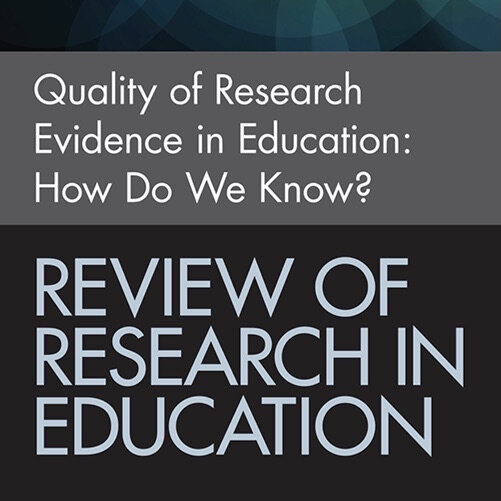The Review of Research in Education (RRE), published annually by the American Education Research Association, is one of the top ten journals in the field. To publish in RRE is both humbling and empowering — a rare opportunity to bring to light issues that are core to my passion as a researcher and author: Equity and access for deaf people.
Each annual issue of RRE is centered on a theme, with contributions curated to offer a unique and important lens to advance the state of the field. The 2021 volume focuses on what we mean by “evidence” in educational research and practice. “The persistence of inequitable education is the fundamental fact facing education researchers as we reflect on the quality and value of the evidence we produce,” note the editors in the volume’s introduction.
This is a high-stakes issue. Evidence and our use of it as scholars is the currency of acceptance and credibility in our work, and quality data is used to shape policy and practice for deaf students across the country.
As the lead author of Evidence-based Practices in Deaf Education: A Call to Center Research and Evaluation on the Experiences of Deaf People, I found myself finding clarity in purpose and taking more risks than ever before. There are some statements in this piece that people may find challenging, even running contrary to our traditional approaches to research training and practice. I am grateful to my co-author, Dr. Carrie Lou Garberoglio, for her continued partnership and brave scholarship, and to the staff at the National Deaf Center on Postsecondary Outcomes for their input and feedback during the writing process.
The main purpose of this article is to call for a deaf-centered approach in examining evidence in deaf education and related fields. This will require intentional, ongoing change in research design, data collection, and dissemination.
Some key strategies include:
Build from the deaf perspective. Quality research design must learn directly from deaf people about what is effective and beneficial in their educational experiences. This may seem to be an obvious source of information, but in reality, deaf perspectives have largely been overlooked in the development of and thinking about evidence, validity, and success in educational interventions. Evidence of effectiveness has, for many years, been determined primarily by hearing professionals working with deaf populations. Yet deaf individuals themselves have rich and invaluable experiences that are critical to understanding both the systemic barriers that lead to education and employment gaps as well as strategies for navigating through them.
Eliminate audism from research design. Audism is the point of view that hearing is better than deaf, and that deafness is something that needs to be eradicated. Research and evaluation in deaf education often seem to follow a standard script: deaf people perform below their hearing peers, interventions have minimal effects, and, finally, claims that more research is needed. The deaf person is largely invisible in this approach and exists solely as something that needs to be fixed. These views and “evidence” of failure spill over into low expectations for deaf people both in schools and in the workplace.
Address systemic barriers. Systemic barriers to success often cause many of the learning and educational outcomes — barriers such as lack of access to robust language models, social isolation, siloed services and supports, negative attitudes about deaf people, and academic and employment settings that are unable or unwilling to shift toward models of greater accessibility for all participants. This foundational understanding of system factors and differential pathways is often missing from how data are collected and interpreted in the research literature.
Develop deaf leadership and scholars. High-quality, relevant research in education requires scholars who are rigorously trained, deeply mentored, and connected to professional networks, and who have opportunities and access to funding to support their work. A culturally relevant perspective is an essential part of developing a robust set of evidence-based practices, and this requires the development and training of deaf education researchers and expansion of their work. Deaf scholars, however, often face many barriers to accessible training and mentoring opportunities and are a product of the same systemic barriers and audism as others in the deaf community. The abled scholarly community can provide essential allyship by supporting accessible environments.
Expand research on diverse perspectives within the deaf community. Deaf people are not all the same. Intersectionality of deaf and other marginalized identities is a critical and yet often overlooked aspect of evidence in deaf education. Research in deaf education and related fields historically under-describes and thus under-considers the diversity of its populations — particularly in the areas of race, ethnicity, gender, and additional disability. Just as one-size-does-not-fit all with learning supports, so too is diversity and flexibility required in research and evaluation design.
The slogan “nothing about us without us” is one that needs deeper consideration throughout the education research development and vetting process.
Deaf-centered approaches can be a constructive part of a broader dialogue on how to support equitable and culturally relevant education research as a whole. Deaf people represent an important reference point for larger conversations around contexts, historical factors, and nuances that are often overlooked when considering answers to “what works” in educational interventions. As we continue to lean into efforts for diversity and inclusion in education, our understanding of what constitutes as evidence, and how to get there, will reflect these core values.
